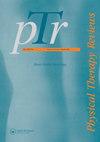颈源性头痛患者的颈椎神经-肌肉-骨骼损伤:一项系统综述和荟萃分析
IF 0.8
Q4 REHABILITATION
引用次数: 1
摘要
摘要背景:颈源性头痛(CGH)患者通常表现出与其他头痛形式相似的头痛症状,但具有神经肌肉骨骼损伤的显著特征。根据目前的诊断标准,尚不清楚哪些损伤对CGH的诊断很重要。目的:与无症状对照组相比,全面回顾诊断为CGH的人的颈部神经肌肉骨骼损伤的证据。方法:检索8个数据库,检索评估CGH患者神经肌肉骨骼损伤的相关研究。评估偏倚风险和证据的总体质量,并进行荟萃分析。结果:纳入了16项研究,其中大多数研究的偏倚风险较低。与无症状对照组相比,CGH受试者的联合颈屈伸ROM(MD−9.26˚,95%CI:−12.24˚,−6.27˚,I2=6%)、侧屈ROM(MD:−2.97˚、95%CI:5.48˚,–0.46˚、I2=51%)和旋转ROM(MD:−13.57,95%CI:−16.10,−11.03,I2=99%)降低。头痛侧的上颈椎旋转ROM显著降低(MD:−15.07˚,95%CI:−16.61˚,−13.53˚,I2=68%)。同样,颈屈肌(MD:−33.70˚,95%CI:−47.23˚,−20.16˚,I2=0%)和伸肌力量(MD:–55.78,95%CI:−77.56,−34.00,I2=0%)在CGH受试者中降低,同时颅椎角降低。CGH受试者的中枢感觉没有明显受损。所有评估结果的证据确定性总体评分从高到低。结论:CGH患者宫颈ROM和肌肉功能明显下降,证据水平从高到低不等。本文章由计算机程序翻译,如有差异,请以英文原文为准。
Cervical neuro-musculoskeletal impairments in people with cervicogenic headache: a systematic review and meta-analysis
Abstract Background: People with cervicogenic headache (CGH) typically present with headache symptoms similar to other headache forms but with distinguishing features of neuro-musculoskeletal impairments. With current diagnostic criteria it is unclear which impairments are important for CGH diagnosis. Objective: To comprehensively review the evidence for cervical neuromusculoskeletal impairments in people with a diagnosis of CGH when compared to asymptomatic controls. Methods: Eight databases were searched for relevant studies evaluating neuro-musculoskeletal impairments in people with CGH. Risk-of-bias and overall quality of the evidence were assessed and meta-analyses performed. Results: Sixteen studies were included, the majority with low risk of bias. In comparison with asymptomatic controls the subjects with CGH presented with reduced combined cervical flexion-extension ROM (MD −9.26˚, 95% CI: −12.24˚, −6.27˚, I2 = 6%), side flexion ROM (MD: −2.97˚, 95% CI: 5.48˚, −0.46˚, I2 = 51%), and rotation ROM (MD: −13.57, 95% CI: −16.10, −11.03, I2 = 99%). Upper cervical rotation ROM was markedly reduced towards the headache side (MD: −15.07˚, 95% CI: −16.61˚, −13.53˚, I2 = 68%). Similarly, cervical flexor (MD: −33.70˚, 95% CI: −47.23˚, −20.16˚, I2 = 0%) and extensor strength (MD: −55.78, 95% CI: −77.56, −34.00, I2 = 0%) was reduced in subjects with CGH along with reduced craniovertebral angle. Kinaesthetic sense was not significantly impaired in subjects with CGH. The overall rating score for certainty of evidence was high to very low for all assessed outcomes. Conclusion: People with CGH have significantly decreased cervical ROM and muscle function with level of evidence ranging from high to very low.
求助全文
通过发布文献求助,成功后即可免费获取论文全文。
去求助
来源期刊

Physical Therapy Reviews
REHABILITATION-
CiteScore
1.30
自引率
0.00%
发文量
26
期刊介绍:
Physical Therapy Reviews is an international journal which aims to publish contemporary reviews, discussion papers and editorials within physical therapy, and in those basic and clinical sciences which are the basis of physical therapy. The journal is aimed at all those involved in research, teaching and practice within the area of physical therapy. Reviews (both descriptive and systematic) are invited in the following areas, which reflect the breadth and diversity of practice within physical therapy: •neurological rehabilitation •movement and exercise •orthopaedics and rheumatology •manual therapy and massage •sports medicine •measurement •chest physiotherapy •electrotherapeutics •obstetrics and gynaecology •complementary therapies •professional issues •musculoskeletal rehabilitation
 求助内容:
求助内容: 应助结果提醒方式:
应助结果提醒方式:


